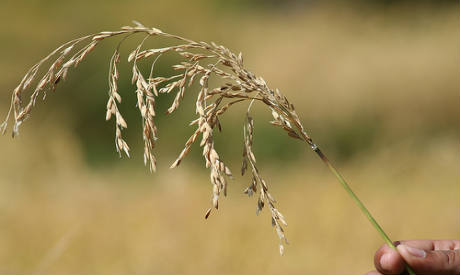
A farmer in Bihar, India grew a world record 22.4 tonnes of rice on one hectare of land. This yield beat out Yuan Longping, who has been known as the "father of rice" in China. It also yielded more than the International Rice Research Institute in the Philippines, any European or American seed yields and all the companies who use GMOs. This was accomplished without chemicals or GMOs.
So what was the magic formula? The process utilized is known as the System of Rice Intensification (SRI) which was a method first developed in Madagascar in the 1980s by Jesuit priest and agronomist, Henri de Laulanie. Norman Uphoff, director and activist for sustainable agriculture at Cornell University further developed the ideas and managed to spread the message throughout Asia. Uphoff points out that for the past 40 years scientists have been solely focused on changing the genes of seeds. He believes that there needs to be a return to nurturing crops and soil in order to sustainably increase yields.
He certainly is onto something. As stated by The SRI International Network and Resources Center (or SRI-Rice), “SRI methods have been validated in 30 countries across a wide range of agro ecosystems — from the equator to temperate climates, and from sea level to 2700 meters above sea level. The number of countries where SRI has been proven and where it is expanding continues to increase. Countries recently joining the SRI club include Bhutan, Brazil, Iran, Iraq, Afghanistan and Zambia.” The Resources Center and network was established in 2010 after a generous donation from Canadian actor Jim Carrey’s Better U Foundation (BUF).
Here are some of the advantages of using the SRI method:
- A higher yield means more tons of rice per hectare or per acre
- Requires less seed and less water due to plant populations being reduced, and paddy fields not being continuously flooded
- Does not require the purchase of new seeds, because most rice varieties will yield higher amounts
- Greater accessibility for lower income communities, who need to get the maximum benefit from their limited land, labor, water and capital
- Can be adapted and used with any scale of rice production which raises the productivity of land, labor, water and capital and produces a better yield
High tech industries are reluctant to invest in these innovations which have been around for 25 years but have hardly been recognized for their success until only recently. The preference continues to be seed modification and GMOs despite poor yields and sometimes tragic results for farmers. Why can’t we see the forest for the trees? Perhaps this quote from agronomist Anil Verma makes the most sense of the issue, where he states that "If any scientist or a company came up with a technology that almost guaranteed a 50% increase in yields at no extra cost they would get a Nobel prize. But when young Biharian farmers do that they get nothing. I only want to see the poor farmers have enough to eat."
Photo credit: Global Crop Diversity Trust




